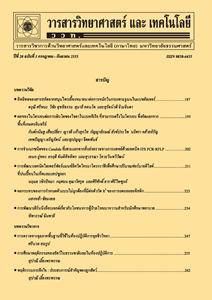Effect of Salt Stress on Phenolic Contents and Antioxidant Activity of Germinated Brown Rice
Main Article Content
Abstract
Nowadays, the consumption of germinated brown rice becomes a popular health food because of their high nutritional value and antioxidants compared with normal brown and white rice. It has been found that salt stress during germination affects the contents of antioxidant compounds. Therefore, the aim of this research was to study the effect of salt stress on total phenolic contents and antioxidant activity in germinated brown rice. The comparative study of salt stress from sodium chloride (NaCl) at various concentrations was performed in 3 rice cultivars, i.e. riceberry, Sung-yod Phatthalung and Kao Dok Mali 105. From the results, Sung Yod Phatthalung extract showed the highest total phenolic content of 707.96±0.02 mg GAE/g extract, and antioxidant activities assayed by DPPH and ABTS methods with EC50 values of 8.73±0.04 and 8.13±0.12 µg/mL, respectively. Rice sprout of Sung Yod Phatthalung soaked in 100 mM NaCl showed total phenolic contents of 852.04±0.003 mg GAE/g extract which was higher than that of the control (487.43±0.010 mg GAE/g extract).
Article Details
References
Sutharut, J. and Sudarat, J., 2012, Total anthocyanin content and antioxidant activity of germinated colored rice, Int. Food Res. J. 19: 215-221.
Sompong, R., Siebenhandl-Ehn, S., Linsberger-Martin, G. and Berghofer, E., 2011, Physicochemical and antioxidative properties of red and black rice varieties from Thailand, China and Sri Lanka, Food Chem. 124: 132-140.
Thammapat, P., Meeso, N. and Siriamornpun, S., 2015, Effects of NaCl and soaking temperature on the phenolic compounds, alpha-tocopherol, gamma-oryzanol and fatty acids of glutinous rice, Food Chem. 175: 218-24.
Kibria, M.G., Hossain, Y.M. and Hoque, M.A., 2017, Antioxidant defense mechanisms of salinity tolerance in rice genotypes, Rice Sci. 24: 155-162.
Chen, X.Q., Nagao, N., Itani, T. and Irifune, K., 2012, Anti-oxidative analysis, and identification and quantification of anthocyanin pigments in different coloured rice, Food Chem. 135: 2783-2788.
Moongngarm, A. and Saetung, N., 2010, Comparison of chemical compositions and bioactive compounds of germinated rough rice and brown rice, Food Chem. 122: 782-788.
Chen, H.H., Chang, H.C., Chen, Y.K., Hung, C.L., Lin, S.Y. and Chen, Y.S., 2016, An improved process for high nutrition of germinated brown rice production: Low-pressure plasma, Food Chem. 191: 120-127.
Chutipaijit, S., Cha-um, S. and Somporn pailin, K., 2009, Differential accumulations of proline and flavonoids in indica rice varieties against salinity, J. Bot. 41: 2497-2506.
Umnajkitikorn, U., Faiyue, B. and Saengnil, K., 2013, Enhancing antioxidant properties of germinated Thai rice (Oryza sativa L.) cv. Kum Doi Saket with salinity, J. Rice Res. 1: 1-8.
Daiponmak, W., Senakun, C. and Siriamornpun, S., 2014, Antiglycation capacity and antioxidant activities of different pigmented Thai rice, Int. J. Food Sci. Technol. 49: 1805-1810.
Thammapat, P., Meeso, N. and Siriamornpun, S., 2015, Effects of NaCl and soaking temperature on the phenolic compounds, -tocopherol, -oryzanol and fatty acids of glutinous rice, Food Chem. 175: 218-224.
Chutipaijit, S., Cha-um, S. and Somporn pailin, K., 2011, High contents of proline and anthocyanin increase protective response to salinity in Oryza sativa L. spp. Indica, Aus. J. Crop Sci. 5: 1191-1195.
Moongngarm, A. and Khomphiphatkul, E., 2011, Germination time dependence of bioactive compounds and antioxidant activity in germinated rough rice (Oryza sativa L.), Am. J. Appl. Sci. 8: 15-25.
Prior, R.L., Wu, X. and Schaich, K., 2005, Standardized methods for the determination of antioxidant capacity and phenolics in foods and dietary supplements, J. Agric. Food Chem. 53: 4290-4302.
Floegel, A., Kim, D.O., Chung, S.J., Koo, S.I. and Chun, O.K., 2011, Comparison of ABTS/DPPH assays to measure antioxidant capacity in popular antioxidant-rich US foods, J. Food Comp. Anal. 24: 1043-1048.
AbdElgawad, H., Zinta, G., Hegab, M.M., Pandey, R., Asard, H. and Abuelsoud, W., 2016, High salinity induces different oxidative stress and antioxidant responses in maize seedlings organs. Front, Plant Sci. 7: 276-280.


